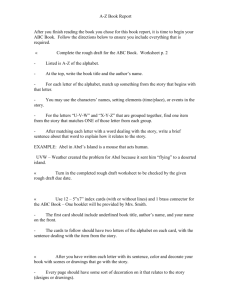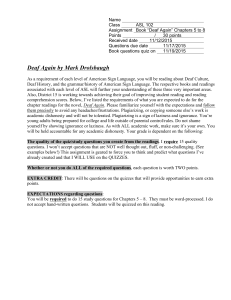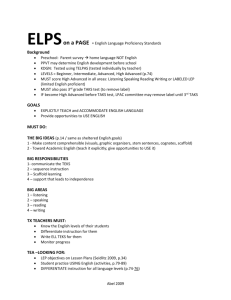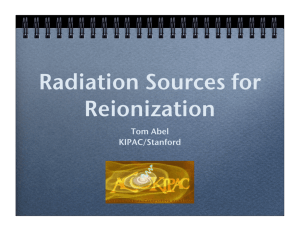Studying Star Formation from First Principles?
advertisement
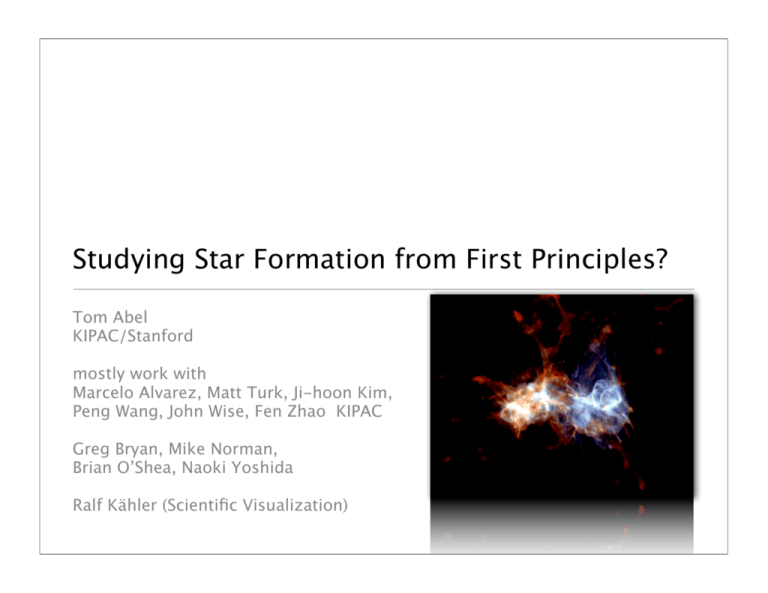
Studying Star Formation from First Principles? Tom Abel KIPAC/Stanford mostly work with Marcelo Alvarez, Matt Turk, Ji-hoon Kim, Peng Wang, John Wise, Fen Zhao KIPAC Greg Bryan, Mike Norman, Brian O’Shea, Naoki Yoshida Ralf Kähler (Scientific Visualization) Talk Outline • First Objects are very massive isolated stars • First stars: HII regions, Supernovae, BH accretion • Properties of First Galaxies • ISM and molecular cloud formation • Making Galaxies one star at a time • Star formation in general • Physics Challenges • Computational Challenges • public version of enzo at: http://lca.ucsd.edu/portal/software/enzo Recap First Stars are isolated and very massive • Theoretical uncertainty: 30 - 300 solar mass Many simulations with four very different numerical techniques and a large range of numerical resolutions have converged to this result. Some of these calculations capture over 20 orders of magnitude in density! Non-equilibrium chemistry & cooling, three body H2 formation, chemical heating, H2 line transfer, collision induced emission and its transport, and sufficient resolution to capture chemo-thermal and gravitational instabilities. Stable results against variations on all so far test dark matter variations, as well as strong soft UV backgrounds. consistent with observations! • Perfectly Could have been a real problem! cosmological: Abel 1995; Abel et al 1998; Abel, Bryan & Norman 2000, 2002; O’Shea et al 2006; Yoshida et al 2006; Gao et al 2006, idealized spheres: Bodenheimer 1986; Haiman et al 1997; Omukai & Nishi 1998; Bromm et al 1999,2000,2002; Ripamonti & Abel 2004 other talks at this conference: Volker Bromm, Brian O’Shea, Naoki Yoshida Tumultuous Life • Entire mass range are strong UV emitters • Live fast, die young. (2.7 Myr) • Fragile Environment • Globular Cluster mass halo but ~100 times as large -> small vesc ~ 2 km/s • Birth clouds are evaporated Galaxies; One Star at a Time Tom Abel KIPAC/ Stanford CALIFORNIA NEBULA, NGC1499 500 pc = 1,500 light years away 30 pc long Xi Persei, ﻣﻨﻜﺐmankib, Shoulder of Pleiades: O7.5III 330,000 solar luminosities ~40 solar masses, Teff=3.7e4K 3D Cosmological Radiation Hydrodynamics Focus on point sources Early methods: Abel, Norman & Madau 1999 ApJ; Abel & Wandelt 2002, MNRAS; Variable Eddington tensors: Gnedin & Abel 2001, NewA Latest: Abel, Wise & Bryan 06 ApJL Keeps time dependence of transfer equation Adaptive ray-tracing of PhotonPackages using HEALPIX pixelization of the sphere. Photon conserving at any resolution. Parallel using MPI and dynamic load balancing. ∂Iν 1 ∂Iν + = −κIν c ∂t ∂r Transfer done along adaptive rays Case B recombination rho Early HII regions in 3D HII region T xe 1Myr 2.7Myr 150pc 8Myr 3kpc, 1/4 box Redshift ~20 fH2 O’Shea, Abel, Whalen & Norman 05 Abel, Wise & Bryan 07 ApJL The First HII Regions 1D spherical: Whalen, Abel & Norman 05; Kiteyama &Yoshida 05 0 5 -1 B A 10 -2 4 10 10 -3 10 3 -4 10 10 -5 10 -6 -3 Gas Density [cm ] 10 C 3 10 2 10 D t = 0 yr 0.1 Myr 1 Myr 2.7 Myr 8 Myr 20 15 10 1 10 0 5 -1 0 10 10 -2 10 1 10 Radius [pc] 100 Temperature [K] 10 1 10 Radius [pc] vr [km/s] _ e , H2 Fraction 10 -5 100 John Wise,3DTomAMR: Abel (KIPAC) & Greg Bryan (Columbia) 2007 Surprising Life - Many uncertainties from inaccurate stellar evolution predictions! • No three dimensional stellar evolution calculations feasible. No ab initio predictions possible at present. • Angular momentum transport • Mixing from core, mixing into the atmosphere? • Stellar winds, as well as episodic mass loss? • Magnetic dynamo? At proto-stellar densities: guaranteed seed field of ~ 4 ×10-10 Gauss from recombination. Larger contribution from Biermann battery plausible • Can do: • Proto-stars (1st & 2nd generation) • HII regions (HeII & HeIII regions) • Metal enrichment & potential GRB remnants • Beginning of Cosmic Reionization • Relevant mass range : PopIII-1: 30 - 300 solar mass and PopIII-2: 10 - 100 Insignificant BH accretion - no mini quasars through this process. Alvarez, Wise & Abel in prep. First few hundred million years: Cosmic ~7 kpc halo masses at redshift stars form within them 10,000 such patches make Milky Way ~ 1e5 popIII remnants early metal enrichment John Wise & Tom Abel (KIPAC) First few hundred million years: Cosmic ~7 kpc 10,000 such patches make Milky Way ~ 1e5 popIII remnants early metal enrichment John Wise & Tom Abel (KIPAC) Beginning of cosmic reionization electrons/ UV photon 1.2 kpc proper Number of stars: • SimA-RT: 19 (11 within rvir) • SimB-RT: 29 (22 within rvir) • SimB-SN: 24 (4 within rvir) John Wise & Tom Abel (KIPAC) 0.20 0.15 0.10 No SF SF SF + SNe Total mass 7 10 6 10 0.05 5 Spin param. 0.00 10 0.1 0.01 35 DM Gas, No SF Gas, SF Gas, SF + SNe 30 25 Redshift 20 John Wise & Tom Abel (KIPAC) 15 Total mass [Msun] Baryon fraction Baryon Fraction & Angular Momentum Metal Transport and Mixing Developing an ISM John Wise & Tom Abel 2007 (KIPAC) Radial Profiles – Multi-phase ISM John Wise & Tom Abel (KIPAC) HII regions starting to be confined inside galaxies John Wise & Tom Abel (KIPAC) Making Galaxies one Star at a Time logarithm of gas temperature ~108 solar mass galaxy z~ 20 one star at a time ~ 20 massive stars in progenitor radiative feedback only 2 kpc across Simulation: John Wise & Tom Abel 2007 logarithm of gas density Application to present day star formation: 30 solar mass cloud jeans number ~ 1 Mach 2 decaying turbulence thermal + turbulent pressure equilibrium with ambient medium 31 levels of refinement: 11 orders of magnitude in length dynamic range: dx ~ 5e8 cm 64 cells per jeans length corresponds to 1e6 SPH particles per jeans mass or ~ 1e13 SPH particles for traditional (non-splitting) scheme This run takes a few days on 16 (old) processors 2pc log10 Temperature log10 Density 2e-2 pc Mass = 30 Msun Density = 5.65e-22 g/cm^3 Radius = 2.932e18 cm = 0.95 pc Temperature = 10 K, Mu = 2, Gamma = 1.4 Initial isothermal sound speed=0.203192 km/s Surface density = 2.21e-3 g/cm^2 Medium Density = 5.65e-23 g/cm^3 The time unit is such that t=1 is exactly one initial free fall time 2e-4 pc New version of enzo: Hydro: RK2, HLL+PLM MHD with Dedner formalism Neufeld et al. cooling, EOSs Multi-species chemistry Radiation transport Wang & Abel 2007 2e-6 pc Physics and algorithmic challenges • MHD • Microphysics: first and foremost: Dust physics, molecules and ions affecting the thermal state of the gas • Radiation transport of cooling radiation • Cosmic ray acceleration, transport and pressure • Subgrid models of B-field dynamos and stellar evolution Computational Challenges • With 1000 resolution elements per jeans mass we currently can follow galaxies that contain 105 local jeans masses. Current maximum galaxy that ! can be hoped to be simulated today ~ 1e10 solar masses. lJ−3 dV = ? MW • HII region dynamics requires resolution ~ 0.01 - 0.1 pc around massive star forming regions • Effective load balancing for tens of thousands of processors • Effective data mining and analysis framework Building galaxies one star at a time. Why now? • JWST, ALMA, LOFAR, MWA, etc. will not be able to observe individual stars but the smallest high redshifts galaxies as yet. • Target dates: 2013 • We can and should predict the properties of these first galaxies to unprecedented detail: - metals, stellar content, Lyman alpha strengths, nebular emission lines, etc. before they are seen. • Compare with nearby fossil record in Summary • Wide range of birth, life & death of the first massive stars are being explored on super computers. Second generation primordial stars have lower mass than the first ones. • HII regions of the first stars evaporate their host-halos leave a medium with ~ 1 cm-3 density but can we really assume no winds? Need better 3D stellar evolution calc. • Enormous impact on subsequent structure formation • different angular momentum of gas vs. dark matter in first galaxies • turbulence/ISM • Black hole accretion limited • seed the first magnetic fields • etc .... • Developed methods are very well suited to study star formation through cosmic time Strong H2 suppression from dissociating UV 1.2 proper kpc Machacek, Bryan, Abel 2002 John Wise & Tom Abel, ApJ 2007 O’Shea, Norman 2007

